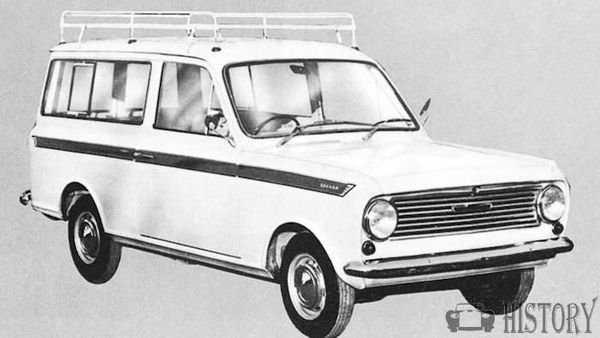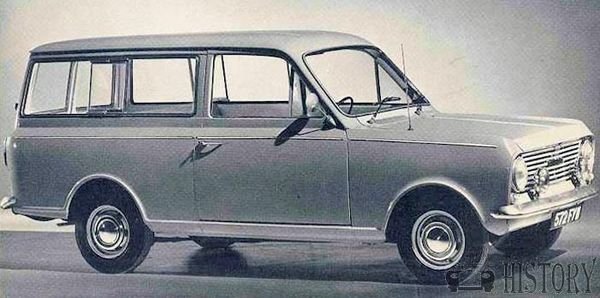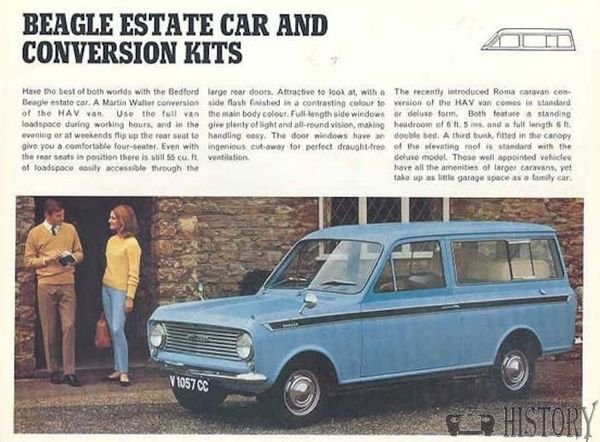Bedford Beagle
 |
|
| Manufacturer | Bedford Vehicles |
|---|---|
| Production | 1964 to 1973 |
| Assembly | Luton, United Kingdom |
| Class | Light commercial vehicle |
| Body style | Estate |
| Layout | Longitudinal front engine, rear-wheel drive |
| Engine | 1.0-1.2L I4 |
| Transmission | 4-speed manual |
| Wheelbase | 91.50 in, 2,324 mm |
| Length | 150.20 in, 3,815 mm |
| Width | 59.41 in, 1,509 mm |
| Height | 59.49 in, 1,511 mm |
| Kerb weight | 1,539 1b, 698 kg |
The Bedford Beagle was a Light estate vehicle produced between 1964 and 1973 by Bedford in Luton, England. part of Vauxhall.
History
The Bedford Beagle was an estate car conversion of the Bedford HA 8cwt van with integral chassis and a carrying capacity of 882 1b, (400 kg) which itself was based on the Vauxhall Viva HA built over several generations.The estate car has 2 doors and 5 seats the front seats separate. The conversions were undertaken by Martin Walter Ltd in Folkestone, Kent, most famous for Dormobile campers based upon the larger Bedford CA commercial vans. Whilst the vans were very common at one time, the Beagle was altogether rarer and there are very few left today.
The Beagle formed the basis of the Roma, a camper van designed by Martin Walter Ltd. Roma was marketed in standard and deluxe forms, both featuring standing headroom of 6 ft 5ins and a full length 6 ft double bed. A third bunk, fitted into the canopy of the elevated roof, is a feature of the deluxe version of the Roma.
The Bedford Beagle or the Vauxhall Viva estate as many prefer to call it is unusual because it started life as a van.This utilitarian vehicle is despatched from Luton to Martin Walter's works in Folkestone from which it emerges in a more civilized form with four seats, more trim and side windows. There are two big advantages of converting a van rather than a saloon: metal surgery is kept to a minimum (the basic shape is unaltered) and being 5 inches taller than the Viva, there is more depth inside for carrying awkward loads.The disadvantage is that the Beagle looks more like a van than most estate cars with its box-shaped body and double swing back doors.
Extremely rigid springs give the Beagle its high 8-cwt. capacity but they also make the ride very bouncy if the car is unladen. On the other hand, this firm suspension improves the handling and there is appreciably less understeer and roll on corners than with the saloon. In this respect it is quite a sporting vehicle although the performance is far from exhilarating, especially with a heavy load on board.The Beagle is all-out at 70 m.p.h. Fuel consumption of the de-rated Viva engine With a lower (7.3:l) compression ratio is reasonable if you dont drive hard. At low speeds the Beagle is very economical (over 50 m.p.g. at 30 m.p.h.)
The Beagle's transmission is identical to that of the Viva saloon the gearbox is better than most with a short, light, stubby lever and synchromesh The servo-assisted drum brakes are fairly light and progressive. The hard springs make the ride extremely bumpy on wavy roads, Although there are only two doors, getting in and out is made easy by the high roof and low sills. there are small centre-swivel panels for back seat passengers.
The major controls—gearlever, handbrake, steering wheel and pedals—are comfortably placed and easy to work, and the visibility is excellent. There are not many fittings nor much furniture inside the Beagle, which is essentially a big capacity workhorse The instruments are like those of the Viva with two round dials housing the clear but optimistic speedometer, petrol gauge and various warning lights. A row of three rocker switches for the lights (side and head) and wipers looks neat and tidy . The choke and windscreen washer could not be similarly confused but they are a long reach away—unlike the fingertip stalk on the steering column which works the indicators, headlamp flasher, dip and horn.
A very deep screen, a vast area of glass all round and reasonably thin Pillars give a panoramic view to all occupants: only the central pillars of the rear swing doors cause a blind spot in the rear-view mirror. A simple two-lever fresh-air heater delivers a strong and very hot stream at maximum setting.Safety points include built-in seat belt anchors, a deeply dished steering wheel and very soft sun visors. The folding rear seat with Washable plastic material covers follows the usual estate car pattern; the cushion lifts forward to a vertical position and the squab folds down to form an extension of the floor behind. The widest point, forward of the rear wheel arches, is 57 in., and the length 59 in. The rear
opening is 35 in. Automatic clips hold both the rear doors open and simple swivel clips secure the seat when it is in position.
Like the Viva, the Beagle needs servicing every 3 000 miles. As th it is a low-maintenance car, only four point needing grease every 30,000 miles. There is plenty of space inside th big engine compartment to reach those ancillaries that an owner is likely to service or inspect. Tools are housed in an underfloor compartment at the back and the spare wheel is from below by turning a square screw head that is normally covere by a plastic cap on the rear floor.

PERFORMANCE: 1,057 cc
- Fuel Consumption 39.8 m/imp gal, 33.1 m/US gal, 7.1 1 x 100 km
- Max Speed 72 mph, 115.9 km/h
- max power (SAE): 47.8 hp at 5,200 rpm
- max torque (SAE): 58 1b ft, 8 kg m at 3,000 rpm
- max number of engine rpm: 5,500
- specific power: 45.2 hp/l
- power- weight ratio: 32.3 lb/hp, 14.6 kg/hp
- speed in direct drive at 1,000 rpm: 15 mph, 24.1 km/h.
- max speeds: 22 mph, 35.4 km/h in 1st gear; 39 mph, 62.8 km/h in 2nd gear; 61 mph, 98.2 km/h in 3rd gear; 72 mph, 115.9 km/h in 4th gear
Introduced in 1964, originally with the 1057 cc engine, the Beagle was basic, with drum brakes all round and minimal interior trim.The improved Mk. 2 Beagle now has a padded facia top and a decorative side flash outside but is otherwise identical.
By 1972 the engine was increased to 1256 cc, bringing the top speed up from 72 mph (116 km/h) to about 80 mph (129 km/h).The front suspension had independent, wishbones, transverse lower leafsprings, telescopic dampers at the rear rigid torque-tube axle, semi-elliptic leafsprings, telescopic dampers.
The Beagle was finally discontinued in 1973. It was more or less replaced by the superior Viva HC estate cars.
Later engine upgrades arrived in 1967 for the MKII (1159 cc)
PERFORMANCE:Mk II 1,159 cc
- engine capacity 70.72 cu in, 1,159 cu cm
- fuel consumption 44 mlimp gal, 36.7 ml US gal, 6.4 1 x 100 km
- max speed 70 mph, 112.7 kmh
- power-weight ratio: 37.5 lb/hp, 17 kg/hp
- max power (DIN): 41 hp at 5,000 rpm
- max torque (DIN): 60 1b ft, 8.3 kg m at 2,000 rpm
- max engine rpm: 5,700
- specific power: 35.4 hp/l
Technical
-
Bedford Beagle Technical details and specifications (1964-1973)
ENGINE:1,057 cc
front, 4 stroke
cylinders: 4, vertical, in line
bore and stroke: 2.93 x 2.40 in, 74.3 x 61 mm
engine capacity: 64.50 cu in, 1,057 cu cm
compression ratio: 7.3
cylinder block: cast iron
cylinder head: cast iron
crankshaft bearings: 3
valves: 2 per cylinder, overhead, push-rods and rockers
camshafts: 1, side
lubrication: gear pump, full flow filter
lubricating system capacity: 7.25 imp pt, 8.67 US pt, 4.1 1
carburation: 1 Solex B 30PSE 1-2 downdraught single barrel carburettor
fuel feed: mechanical pump
cooling system: waterENGINE Mk II 1,159 cc
front, 4 stroke; cylinders: 4, vertical, in line
bore and stroke: 3.06 x 2.40 7.3
cylinder block: cast iron
cylinder head: cast iron
crankshaft bearings: 3
valves: 2 per cylinder, overhead, push-rods and rockers
camshafts: 1, side
lubrication: gear pump, full flow filter
lubricating system capacity: 5.50 imp pt, 6.55 US pt
carburation: 1 Solex PSEl-7 downdraught single barrel carburettor
fuel feed: mechanical pump
cooling system: waterTRANSMISSION
driving wheels: rear
clutch: single dry plate
gearbox: mechanical
gears: 4 + reverse; synchromesh gears: 1st, 2nd, 3rd, 4th
gearbox ratios: 1st 3.765, 2nd 2.213, 3rd 1.404, 4th I, rev 3.707
final drive: hypoid bevel; axle ratio: 4.125.CHASSIS : integral
front suspension: independent, wishbones, transverse lower leafsprings, telescopic dampers
rear suspension: rigid torque-tube axle, semi-elliptic leafsprings, telescopic dampers.STEERING
rack-and-pinion
turns of steering wheel lock to lock: 3.75. 2nd gen 3.14.
turning circle (between walls): 29.2 ft, 8.9 mBRAKES
drum, 2 front leading shoes
area rubbed by linings: front 63 sq in, 406.35 sq cm, rear 63 sq in, 406.35 sq cm, total 126 sq in, 812.70 sq cm.ELECTRICAL EQUIPMENT
voltage: 12 V
battery: 32 Ah
dynamo: 264 W
distributor: LucasDIMENSIONS AND WEIGHT
wheel base: 91.50 in, 2,324 mm
front track: 47.40 in, 1,204 mm
rear track: 48.19 in, 1,224 mm
overall length: 150.20 in, 3,815 mm
overall width: 59.41 in, 1,509 mm
overall height: 59.49 in, 1,511 mm
ground clearance: 5 in, 127 mm
dry weight: 1,539 1b, 698 kg© Motor car History
Service
-
Bedford Beagle Practical Instructions and Service Guide (1964-1973)
MKI
fuel: 85-90 oct petrol
engine oil change: 6.16 imp pt, 7.40 US pt, 3.5 1, SAE 20W-30, change every 3,000 miles, 4,800 km
gearbox oil: 1.06 imp pt, 1.27 US pt, 0.6 1, SAE 80, no change recommended
final drive oil: 1.23 imp pt, 1.48 US pt, 0.7 1, SAE 90, no change recommended
greasing: every 30,000 miles, 48,300 km or 30 months, 4 points
cooling system capacity: 11.34 imp pt, 13.53 US pt, 6.4 1.
tappet clearances : inlet 0.006 in, 0.15 mm, exhaust 0.010 in, 0.25 mm
valve timing : inlet opens 39° before tdc and closes 93° after bdc, exhaust opens 65° before bdc and closes 45° after tdc
tyre pressure (medium load): front 21 psi, 1.5 atm, rear 27 psi, 1.9 atm.
tyres: 5.50 x 12
fuel tank capacity: 7 imp gal, 8.4 1-JS gal, 32 1.
carrying capacity: 882 1b, 400 kgMKII
fuel: 85-90 oct petrol
engine oil: 4.50 imp pt. 5.50 US pt, 2.6 1, SAE 20W-20, change every 6,000 miles, 9,700 km
gearbox oil: 0.90 imp pt. 1.06 US pt, 0.5 1, SAE 90, no change recommended
final drive oil: 1.25 imp pt. 1.48 US pt. 0.7 1, SAE 90, no change recommended
greasing: every 30,000 miles, 48.300 km or 30 months, 4 points
tappet clearances: inlet 0.006 in, 0.15 mm, exhaust 0.010 In, 0.25 mm
valve timing: inlet opens 39° before tdc and closes 93° after bdc, exhaust opens 65° before bdc and closes 45° after tdc
normal tyre pressure: front 21 psi, 1.5 atm, rear 27 psi, 1.9 atm.© Motor car History

